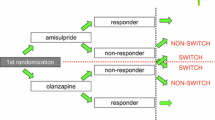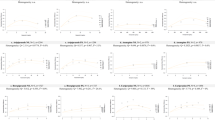Abstract
The objective of the European Post-marketing Observational Serdolect® (EPOS) Study was to compare the safety of treatment with Serdolect (sertindole) with that of usual treatment in patients with schizophrenia, in normal European clinical practice. The EPOS was a multicentre, multinational, referenced, cohort study. Patients were enrolled at 226 centres in ten European countries. The study was prematurely terminated in 1998 as a result of the temporary market suspension of sertindole. Termination of the study reduced the number of patients recruited from the planned 12,000 to 2,321. While the power of the study was weakened, it did provide useful mortality information, which may be useful for future long-term studies. Crude mortality in the sertindole and non-sertindole groups was 1.45 (95% confidence interval, CI 0.53–3.16) and 1.50 (CI 0.72–2.76) deaths/100 patient-years exposed, respectively. There were no more cardiac deaths in the sertindole group than in the non-sertindole group. QT interval prolongation did not translate into an increased risk of death. Sertindole was well tolerated and caused few extrapyramidal symptoms. Although CIs remained large, this post-marketing study does not provide any evidence against the use of sertindole under normal conditions. Sertindole was well tolerated and posed no significant safety problems.
Similar content being viewed by others
References
Hyttel J, Nielsen JB, Nowak G (1992) The acute effect of sertindole on brain 5-HT2, D2 and α1 receptors (ex vivo radioreceptor binding studies). J Neural Transm 89:61–69
Sánchez C, Arnt J, Dragsted N (1991) Neurochemical and in vivo pharmacological profile of sertindole, a limbic-selective neuroleptic compound. Drug Dev Res 22:239–250
Kasper S, Quiner S, Pezawas L (1998) A review of the benefit-risk profile of sertindole. Int J Psychiatry Clin Pract 2(Suppl 2):S59–S64
Kasper S, Hale AS, Azorin JM, Möller HJ (1999) Benefit-risk evaluation of olanzapine, risperidone and sertindole in the treatment of schizophrenia. Eur Arch Psychiatry Clin Neurosci 249(Suppl 2):2–14
Perquin L, Steinart T (2004) A review of the efficacy, tolerability and safety of sertindole in clinical trials. CNS Drugs 18(Suppl 2):19–30
Daniel DG, Wozniak P, Mack RJ, McCarthy BG (1998) Long-term efficacy and safety comparison of sertindole and haloperidol in the treatment of schizophrenia. Psychopharmacol Bull 34:61–69
Hale A, Azorin J-M, Kasper S, Maier W, Syvälahti E, Van der Burght M, Sloth-Nielsen M, Wehnert A (2000) Sertindole is associated with a low level of extrapyramidal symptoms in schizophrenic patients: results of a phase III trial. Int J Psychiatry Clin Pract 4:47–54
Zimbroff DL, Kane JM, Tamminga CA, Daniel DG, Mack RJ, Wozniak PJ, Sebree TB, Wallin BA, Kashkin KB (1997) Controlled, dose-response study of sertindole and haloperidol in the treatment of schizophrenia. Am J Psychiatry 154:782–791
Peuskens J, Moore N, Azorin JM, Toumi M, Cochran J (2007) The European sertindole safety and exposure survey: a follow-up study of 8, 600 patients. Pharmacoepidemiol Drug Saf 16:804–811
Azorin JM, Murteira S, Hansen K, Toumi M (2008) Evaluation of patients on sertindole treatment after failure of other antipsychotics: a retrospective analysis. BMC Psychiatry 8:16. http://www.biomedcentral.com/search/results.asp?terms=niche+study&area=2023®isterlist=&Submitted=&x=26&y=8. Published 14 March 2008, accessed 24 September 2008
Lançon C, Toumi M, Sapin C, Hansen K (2008) The Sertindole Safety Survey: a retrospective analysis under a named patient use programme in Europe. BMC Psychiatry 8:57 http://www.biomedcentral.com/search/results.asp?terms=sertindole+safety+study&area=2023®isterlist=&Submitted=&x=31&y=8. Published 18 July 2008, accessed 24 September 2008
Serdolect® (sertindole) Summary of Product Characteristics. http://www.serdolect.com/content/downloadarea/pdf/serdolect_spc.pdf
Lindström E, Farde L, Eberhare J, Haverkamp W (2005) QTc interval prolongation and antipsychotic drug treatments: focus on sertindole. Int J Neuropsychopharmacol 8:615–629
Montross L, Kasckow J (2005) Suicide among patients with schizophrenia: a consideration of risk and protective factors. Ann Clin Psychiatry 17:173–182
Montout C, Casadebaig F, Lagnaoui R, Verdoux H, Philippe A, Begaud B, Moore N (2002) Neuroleptics and mortality in schizophrenia: prospective analysis of deaths in a French cohort of schizophrenic patients. Schizophr Res 57:147–156
Acknowledgments
The authors would like to thank the members of the EPOS Advisory Safety Committee: R. Campbell (Department of Social Medicine, University of Bristol, Bristol, UK), J. Camm (Division of Cardiac and Vascular Sciences, Cardiological Sciences, St George’s, University of London, London, UK), T. Barnes (Department of Psychosocial Medicine, Imperial College London, London, UK), B. Everitt (Retired; now Professor Emeritus, formerly of the Institute of Psychiatry, King’s College, London, UK), and S. Thomas (Wolfson Unit of Clinical Pharmacology, School of Clinical and Laboratory Sciences University of Newcastle, Newcastle, UK). H. Lundbeck A/S, Copenhagen, Denmark provided the grant for this study.
Conflict of interest statement
Siegfried Kasper has received research grants, consultancy fees and lecture fees from a number of pharmaceutical companies in the area of CNS development: Eli Lilly, Bristol Myers Squibb, GlaxoSmithKline, Organon, Servier, AstraZeneca, Pfizer, Janssen Pharmaceutica, Novartis, and Lundbeck, the manufacturer of sertindole. Hans-Jürgen Möller has received research grants from, or is on the advisory board of, or is a member of the speaker panel of: AstraZeneca, BMS, GSK, Janssen Cilag, Lilly, Lundbeck, Merck, Novartis, Pfizer, Sanofi Aventis, Servier, and Wyeth. Anthony Hale is on the advisory board of, or is a member of the speaker panel of: AstraZeneca, BMS, Lilly, and Lundbeck, the manufacturer of sertindole.
Author information
Authors and Affiliations
Corresponding author
Rights and permissions
About this article
Cite this article
Kasper, S., Möller, HJ. & Hale, A. The European Post-marketing Observational Sertindole Study: an investigation of the safety of antipsychotic drug treatment. Eur Arch Psychiatry Clin Neurosci 260, 59–68 (2010). https://doi.org/10.1007/s00406-009-0018-0
Received:
Accepted:
Published:
Issue Date:
DOI: https://doi.org/10.1007/s00406-009-0018-0




